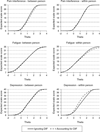Psychometric characteristics of daily diaries for the Patient-Reported Outcomes Measurement Information System (PROMIS®): a preliminary investigation
- PMID: 23180166
- PMCID: PMC3622151
- DOI: 10.1007/s11136-012-0323-3
Psychometric characteristics of daily diaries for the Patient-Reported Outcomes Measurement Information System (PROMIS®): a preliminary investigation
Abstract
Purpose: The Patient-Reported Outcomes (PRO) Measurement Information System (PROMIS(®)) has developed assessment tools for numerous PROs, most using a 7-day recall format. We examined whether modifying the recall period for use in daily diary research would affect the psychometric characteristics of several PROMIS measures.
Methods: Daily versions of short-forms for three PROMIS domains (pain interference, fatigue, depression) were administered to a general population sample (n = 100) for 28 days. Analyses used multilevel item response theory (IRT) models. We examined differential item functioning (DIF) across recall periods by comparing the IRT parameters from the daily data with the PROMIS 7-day recall IRT parameters. Additionally, we examined whether the IRT parameters for day-to-day within-person changes are invariant to those for between-person (cross-sectional) differences in PROs.
Results: Dimensionality analyses of the daily data suggested a single dimension for each PRO domain, consistent with PROMIS instruments. One-third of the daily items showed uniform DIF when compared with PROMIS 7-day recall, but the impact of DIF on the scale level was minor. IRT parameters for within-person changes differed from between-person parameters for 3 depression items, which were more sensitive for measuring change than between-person differences, but not for pain interference and fatigue items. Notably, mean scores from daily diaries were significantly lower than the PROMIS 7-day recall norms.
Conclusions: The results provide initial evidence supporting the adaptation of PROMIS measures for daily diary research. However, scores from daily diaries cannot be directly interpreted on PROMIS norms established for 7-day recall.
Figures
Similar articles
-
Measurement Equivalence of the Patient Reported Outcomes Measurement Information System® (PROMIS®) Pain Interference Short Form Items: Application to Ethnically Diverse Cancer and Palliative Care Populations.Psychol Test Assess Model. 2016;58(2):309-352. Psychol Test Assess Model. 2016. PMID: 28983449 Free PMC article.
-
Differential Item Functioning Analyses of the Patient-Reported Outcomes Measurement Information System (PROMIS®) Measures: Methods, Challenges, Advances, and Future Directions.Psychometrika. 2021 Sep;86(3):674-711. doi: 10.1007/s11336-021-09775-0. Epub 2021 Jul 12. Psychometrika. 2021. PMID: 34251615 Free PMC article.
-
Development and psychometric properties of the PROMIS(®) pediatric fatigue item banks.Qual Life Res. 2013 Nov;22(9):2417-27. doi: 10.1007/s11136-013-0357-1. Epub 2013 Feb 2. Qual Life Res. 2013. PMID: 23378106 Free PMC article.
-
Ambulatory and diary methods can facilitate the measurement of patient-reported outcomes.Qual Life Res. 2016 Mar;25(3):497-506. doi: 10.1007/s11136-015-1054-z. Epub 2015 Jun 23. Qual Life Res. 2016. PMID: 26101141 Free PMC article. Review.
-
Modifying measures based on differential item functioning (DIF) impact analyses.J Aging Health. 2012 Sep;24(6):1044-76. doi: 10.1177/0898264312436877. Epub 2012 Mar 15. J Aging Health. 2012. PMID: 22422759 Free PMC article. Review.
Cited by
-
Coping as a Moderator of Associations Between Symptoms and Functional and Affective Outcomes in the Daily Lives of Individuals With Multiple Sclerosis.Ann Behav Med. 2023 Apr 5;57(3):249-259. doi: 10.1093/abm/kaac050. Ann Behav Med. 2023. PMID: 36591810 Free PMC article.
-
Association of cannabis use with patient-reported pain measures among adults with chronic pain in US states with medical cannabis programs.Reg Anesth Pain Med. 2024 Sep 2;49(9):642-649. doi: 10.1136/rapm-2023-104833. Reg Anesth Pain Med. 2024. PMID: 37923347
-
Ecological validity and clinical utility of Patient-Reported Outcomes Measurement Information System (PROMIS®) instruments for detecting premenstrual symptoms of depression, anger, and fatigue.J Psychosom Res. 2014 Apr;76(4):300-6. doi: 10.1016/j.jpsychores.2014.01.010. Epub 2014 Feb 7. J Psychosom Res. 2014. PMID: 24630180 Free PMC article.
-
Acceptability and feasibility of fecal microBIOME and serum metabolite sample collection in people with end-stage kidney disease and pain being treated with HemoDialysis: A pilot study (BIOME-HDp).Contemp Clin Trials Commun. 2022 Sep 5;29:100995. doi: 10.1016/j.conctc.2022.100995. eCollection 2022 Oct. Contemp Clin Trials Commun. 2022. PMID: 36105265 Free PMC article.
-
Identification of distinct fatigue trajectories in patients with breast cancer undergoing adjuvant chemotherapy.Support Care Cancer. 2015 Sep;23(9):2579-87. doi: 10.1007/s00520-015-2616-x. Epub 2015 Jan 27. Support Care Cancer. 2015. PMID: 25876159 Free PMC article.
References
-
- Cella D, Riley W, Stone A, Rothrock N, Reeve B, Yount S, et al. The Patient-Reported Outcomes Measurement Information System (PROMIS) developed and tested its first wave of adult self-reported health outcome item banks: 2005–2008. Journal of Clinical Epidemiology. 2010;63(11):1179–1194. - PMC - PubMed
-
- Institute of Medicine. Leading health indicators for healthy people 2020: Letter Report. Washington, DC: National Academies Press; 2011. - PubMed
-
- Leidy NK, Wilcox TK, Jones PW, Murray L, Winnette R, Howard K, et al. Development of the EXAcerbations of Chronic Obstructive Pulmonary Disease Tool (EXACT): A Patient-Reported Outcome (PRO) Measure. Value in Health. 2010;13(8):965–975. - PubMed
Publication types
MeSH terms
Grants and funding
LinkOut - more resources
Full Text Sources
Miscellaneous


